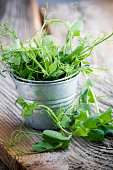Soaking and Sprouting

by Miwa Hiroe
The wintry white landscape has melted to reveal a collage of browns that are morphing daily into an increasingly vibrant green. The soil is again becoming warm and workable, but the majority of us are still weeks away from eating freshly picked greens. There is a semi quick alternative to help bridge the gap between feasts of earth’s readily consumable bounty. What’s more, the benefits of this culinary practice far surpass satisfying the palate.
Sprouting

Sprouting jars, lids, and trays are available at Infinity.
Sprouting is as easy as it is miraculous. It is soaking seeds, triggering them to transform from their dormant states as nuts, grains, or legumes into living, growing plants. While these foods are nutrient dense as it is, some of the nutrition is lost because of our body’s inability to digest and absorb it. When a seed germinates, the deactivation of anti-growth compounds leads to greater bioavailability, especially of vitamin C, folate, zinc, calcium, and iron.
Sprouting doesn’t just give us more bang for our buck, it also accommodates the immediate “after effect” of eating these foods, especially with grains and legumes. Once in grow mode, the seed breaks down its complex sugars (oligosaccharides) and neutralizes enzyme inhibitors. This makes the food far more digestible and reduces post-consumed fermentation and intestinal gas production. It also reduces the amount of gluten in grains, which wouldn’t help a person with an allergy but may make a huge difference to a person with a gluten sensitivity.
 Sprouts are delicious! They are a way of producing fresh tiny greens any time of the year in mere days. Many sprouts can be eaten raw, adding flavour, texture, and colour. Some legumes and especially kidney beans need to be cooked but sprouting cuts a substantial amount of cooking time. Some nuts, like pecans and walnuts cannot be sprouted, but soaking them still boosts their nutrient availability.
Sprouts are delicious! They are a way of producing fresh tiny greens any time of the year in mere days. Many sprouts can be eaten raw, adding flavour, texture, and colour. Some legumes and especially kidney beans need to be cooked but sprouting cuts a substantial amount of cooking time. Some nuts, like pecans and walnuts cannot be sprouted, but soaking them still boosts their nutrient availability.
The phenomena is that sprouting really is a transformation. It is essentially the first step in  turning a carbohydrate into a tiny vegetable. While carb levels are reduced, protein increases, vitamins and minerals become more available, soluble fiber nearly triples, and the substance goes from being an acid-forming food to an alkaline-forming food. Best of all, these mini superfoods are inexpensive and restricted to no one. All you need are your seeds, water, and a little time.
turning a carbohydrate into a tiny vegetable. While carb levels are reduced, protein increases, vitamins and minerals become more available, soluble fiber nearly triples, and the substance goes from being an acid-forming food to an alkaline-forming food. Best of all, these mini superfoods are inexpensive and restricted to no one. All you need are your seeds, water, and a little time.
Share Your Thoughts